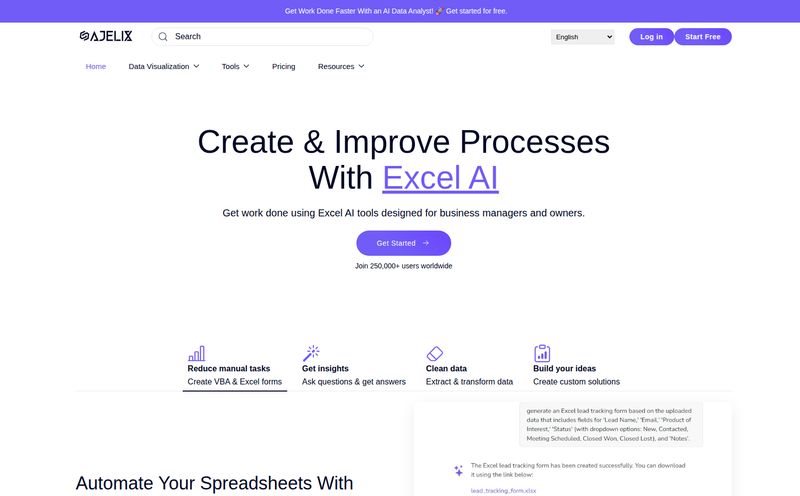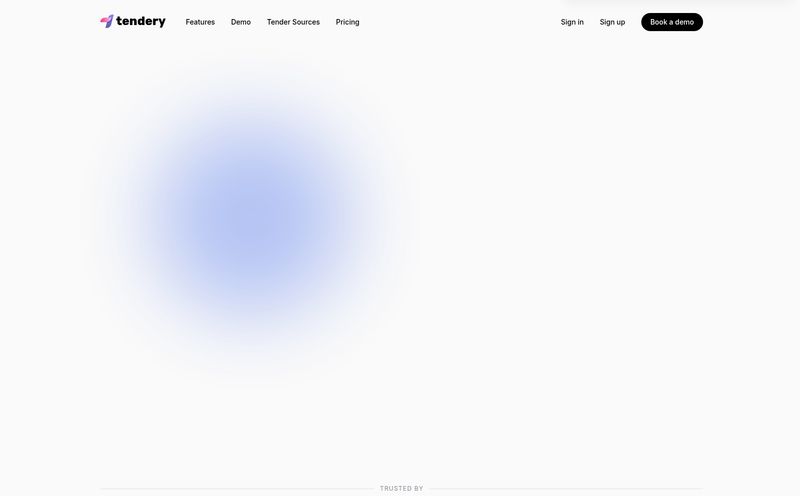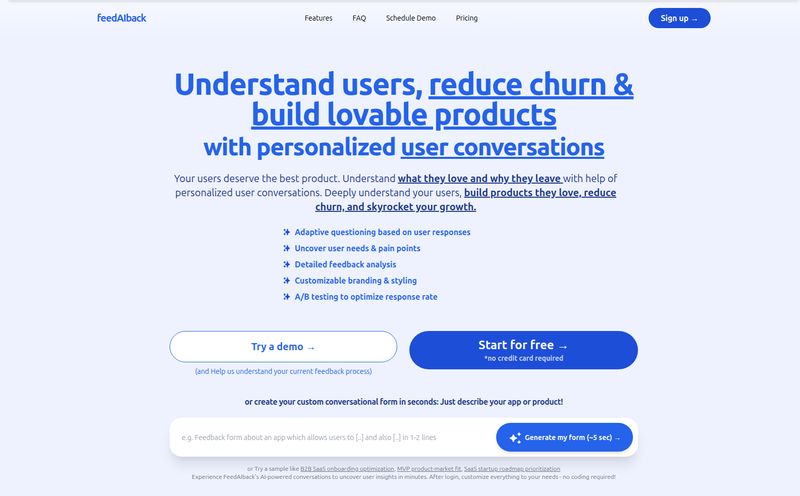As someone who’s spent years neck-deep in SEO, traffic trends, and the general chaos of the internet, I’ve developed a sixth sense for one thing: noise. The sheer, overwhelming, deafening noise of data. We're all drowning in it. Every day is a firehose of social media chatter, news articles, forum posts, and dark web whispers. For a security team or a market analyst, trying to find the one critical signal in that static is like trying to find a specific needle in a continent-sized haystack made of other needles.
It’s exhausting. And honestly, most tools that promise to help just end up giving you a more organized version of the same overwhelming data dump. A prettier dashboard, but the same headache.
So, when I came across Overwatch Data, my initial skepticism was, shall we say, well-developed. The name itself is evocative, isn't it? It brings to mind a silent guardian, a sentinel on a watchtower, seeing everything. The logo, with those piercing eyes staring out of the dark, certainly leans into that vibe. Their tagline is even bolder: "See Beyond the Surface, AI Agents Deliver Fraud and Cyber Threat Intel at Attacker Speed." That’s a big claim. But I was intrigued. Could this actually be different?
What Exactly is Overwatch Data, Anyway?
At its core, Overwatch Data is an OSINT platform. For the uninitiated, OSINT stands for Open-Source Intelligence—information gathered from publicly available sources. Think news sites, social media, public records, the whole shebang. But where Overwatch tries to separate itself from the pack is in its approach. It’s a no-code, AI-driven platform designed not just to show you data, but to give you answers.
Instead of just aggregating feeds, its AI agents work to understand what’s important based on your specific needs. It’s built for entities—companies, government agencies—that need concise, actionable intelligence for things like:
- Cyber Threat Intelligence
- Fraud Detection
- Security Operations
- Supply Chain Risk
- Market Intelligence
It’s less of a search engine and more of a reconnaissance drone that you can program to find exactly what you’re looking for, and it reports back with a summary, not a novel.
Who is This For? It's Not Just for Spies.
While the name and imagery might scream "government black-ops," its application is surprisingly broad. I can immediately see a few teams breathing a sigh of relief with a tool like this.
A cybersecurity team could use it to monitor for mentions of their company's assets on hacker forums or to track the tactics of known threat actor groups. A fraud prevention unit at a bank could track emerging scams or identify mules bragging on social media. I even see massive value for someone like me. Imagine being able to monitor for real-time shifts in consumer sentiment about a new product or tracking a competitor's supply chain issues as they unfold in local news outlets halfway across the world.
It’s for anyone whose job depends on knowing what’s happening out there before it becomes a crisis in here.
It bridges the gap between the C-suite that needs a high-level summary and the analyst on the ground who needs to act fast.
The Features That Actually Matter
Alright, let's get into the guts of the machine. A platform is only as good as its features, and a few of Overwatch's capabilities really stood out to me.
The No-Code Promise: Finally, OSINT for the Rest of Us
This is huge. Traditionally, powerful OSINT tools required a significant amount of technical know-how, maybe even some light coding, to get the most out of them. By making it a no-code platform, Overwatch democratizes access. You don't need a team of developers to set up your monitoring. You can define what you care about in plain English, and the platform does teh heavy lifting. This drastically lowers the barrier to entry and, more importantly, the time to value.
AI That Cuts Through the Noise
Here’s the part that got me genuinely excited. The AI isn't just a buzzword here; it’s the core function. The promise of getting actionable insights instead of raw data is the holy grail. I’m talking about real-time executive summaries that bubble up the most critical information. For any manager or director who has ever had to wade through a 50-page report to find the two sentences that matter, this is a godsend. It's the difference between being handed a library and being handed the exact book and page you need.

Visit Overwatch Data
Chatting With Your Data? Tell Me More.
Okay, this is cool. Overwatch has a feature that allows for a free-form chat with the news data it collects. Think of it like having ChatGPT, but its entire brain is made up of the real-time, relevant intelligence you’ve gathered. Instead of complex filters and boolean queries, you can just ask questions like, "What's the latest chatter about vulnerabilities in our software stack?" or "Show me recent supply chain disruptions for semiconductor manufacturing in Taiwan." This conversational interface feels like the future of data analysis, and it's here now.
Visualizations That Make Sense
We're visual creatures. A spreadsheet of 10,000 data points is meaningless, but a heat map showing where those points are clustered tells a story instantly. Overwatch provides intuitive visualizations—maps, charts, word clouds—that help you see patterns and trends at a glance. You don't need a data science degree to understand what you're looking at, which is exactly how it should be.
The Good, The Bad, and The AI
No tool is perfect, and a real review needs to cover the whole picture. I've been in this game long enough to know that every silver bullet has a bit of lead in it.
What I Love About Overwatch Data
The biggest win, for me, is the combination of its no-code accessibility and its AI-powered summarization. It’s a powerful one-two punch that saves an incredible amount of time and mental energy. The customizability is also a major plus; you're not stuck with a one-size-fits-all solution. You're building your own personal intelligence network. And the potential to get ahead of a crisis—be it a cyber attack, a PR nightmare, or a market shift—is immense. This is proactive intelligence, not reactive damage control.
A Few Things to Keep in Mind
Now, for a dose of realism. The effectiveness of Overwatch is going to depend heavily on how well you define your interests and categories. The classic "garbage in, garbage out" principle applies. If your search parameters are too broad or poorly defined, the AI might struggle to deliver those perfectly concise insights. There will be a learning curve in figuring out how to best instruct your AI agents.
Second, as an OSINT platform, its power is tied to the accuracy and availability of open-source data. If a conversation is happening in a completely sealed-off, private channel, Overwatch won’t see it. That's not a flaw in the tool itself, just the reality of OSINT. And finally, from what I can gather, you may need to go through a demo or a conversation with their team to get full access. This isn't a click-and-buy SaaS tool, which suggests it's aimed at a more enterprise-level client.
What’s the Damage? A Look at Overwatch Data’s Pricing
This is the million-dollar question, isn't it? As of my writing this, Overwatch Data doesn't have a public pricing page. This is pretty common for platforms targeting enterprise and government clients. Pricing is likely customized based on the scale of use, the number of users, and the specific intelligence modules you need.
Your best bet is to take them up on their offer of a Free Threat Assessment. This is the main call-to-action on their site, and it’s a smart move. It gives you a chance to see the platform's power with your own data and gives them a chance to understand your needs and quote you accurately. It's a try-before-you-buy scenario for serious players.
My Final Take: Is Overwatch Data Worth It?
So, does it live up to the hype? In my opinion, for the right organization, absolutely. If you're a team that is constantly reacting to threats and drowning in data feeds, a tool like Overwatch Data could be transformative. It’s not just another data stream; it's a filtration and analysis engine. It’s about shifting from a passive, overwhelmed posture to a proactive, informed one.
The real value isn’t in the data it collects, but in the time it saves and the crises it helps you avert. It's a strategic asset disguised as a software platform. While it might not be for the casual small business owner, for any organization serious about security, fraud, or market intelligence, it's a platform that demands a closer look.
Frequently Asked Questions about Overwatch Data
Is Overwatch Data hard to learn?
Not at all, and that's one of its main selling points. It’s a “no-code” platform, meaning it’s designed to be used by analysts and decision-makers, not just programmers. The conversational chat feature makes it even more accessible.
What kind of data does Overwatch monitor?
It monitors a wide range of open-source intelligence (OSINT). This includes public news sources, social media platforms, forums, and other publicly available data across the global internet to provide comprehensive insights.
Who typically uses Overwatch Data?
The primary users are companies and government entities with a need for high-stakes intelligence. This includes cybersecurity teams, fraud prevention units, supply chain managers, and market intelligence analysts who need to monitor risks and opportunities.
How much does Overwatch Data cost?
Pricing is not publicly listed. It is likely a custom, enterprise-level plan. The best way to find out the cost for your organization is to contact them for their Free Threat Assessment.
Can I use this for my small business?
While it seems geared towards larger organizations due to its enterprise focus and custom pricing model, it never hurts to ask. The Free Threat Assessment would be the definitive way to see if it's a good fit for your specific business needs and budget.
In the end, the internet isn’t getting any quieter. The data firehose is only going to get stronger. Tools like Overwatch Data represent a necessary evolution—moving from just collecting data to actually understanding it at scale. It’s about having that sentinel on the wall that can see in the dark, so you don’t have to.
Reference and Sources
For more information, you can visit the official Overwatch Data website and request their Free Threat Assessment to see the platform in action. All analysis and opinions are based on publicly available information and my own experience in the industry.
(Note: A direct link to the Overwatch Data website would be placed here in a live article.)



